Cómo añadir JavaScript a las páginas y entradas de WordPress: Guía para principiantes

JavaScript es un potente lenguaje de programación que le permite añadir funciones interactivas a su sitio web. Ya se trate de una calculadora dinámica, un reproductor de vídeo o un cuadro de alerta que aparece al hacer clic en un botón, JavaScript ayuda a que su sitio web sea más atractivo y funcional. En esta completa guía, le explicaré cómo añadir JavaScript a sus páginas y entradas de WordPress de forma segura y eficaz, cubriendo varios métodos que se adaptan a diferentes necesidades.

¿Puede utilizar JavaScript en WordPress?
Sí, ¡puede utilizar JavaScript en WordPress! JavaScript se utiliza habitualmente para mejorar la experiencia del usuario (UX) y hacer que los sitios web sean más interactivos y receptivos. Puede utilizar JavaScript para crear alertas emergentes, mostrar mensajes cuando un usuario pasa el ratón por encima de un elemento o incluso añadir herramientas interactivas como calculadoras o validaciones de formularios personalizadas. Aunque añadir JavaScript a WordPress es relativamente sencillo, tener unos conocimientos básicos de HTML y CSS puede ayudarle a sacarle el máximo partido.
Sugerencia: Si está empezando, no se preocupe si algunos términos le parecen abrumadores. Vaya paso a paso y pronto añadirá JavaScript como un profesional.

Aspectos a tener en cuenta antes de añadir JavaScript a WordPress
Antes de añadir JavaScript a su sitio web WordPress, recuerde algunas cosas esenciales. Los errores de JavaScript pueden romper potencialmente su sitio, por lo que siempre es mejor proceder con cautela y seguir estos pasos:
- Haga una copia de seguridad de su sitio: Tenga siempre una copia de seguridad reciente del sitio antes de añadir cualquier código personalizado. Esto incluye la base de datos (que almacena sus entradas, páginas, ajustes y configuración) y los archivos (como imágenes, temas y plugins). Plugins como Jetpack o las copias de seguridad manuales pueden ayudarle a salvaguardar su trabajo.
- Nota personal: ¡No puedo decirle cuántas veces me ha salvado una copia de seguridad! Es una de esas cosas que desearías haber hecho antes de que algo saliera mal.
- Utilice un tema hijo: Un tema hijo es una copia de su tema actual que le permite personalizarlo sin afectar al código original. Si realiza cambios en los archivos del tema principal, podrían sobrescribirse la próxima vez que su tema se actualice. Utilizar un tema hijo también hará que sus modificaciones sean más fáciles de gestionar.
- Entorno de pruebas: Cree un entorno de pruebas donde pueda añadir código JavaScript sin arriesgarse a romper su sitio web en vivo. Servicios como Local de Flywheel o un sitio de ensayo pueden ayudarle a probar los cambios de forma segura.
- Consejo rápido: Un entorno de pruebas es su mejor amigo. Le permite experimentar sin riesgo para su sitio, por lo que puede cometer errores y aprender libremente.

Métodos para añadir JavaScript a WordPress
Existen varios métodos para añadir JavaScript a WordPress, y aquí trataré los más eficaces. Puede elegir el método que mejor se adapte a sus necesidades específicas.
Método 1: Uso de plugins
Si no se siente cómodo escribiendo código o simplemente desea una solución más sencilla, añadir JavaScript a su sitio de WordPress mediante un plugin es la opción más fácil.
- Plugin para insertar encabezados y pies de página: Este plugin le permite añadir código personalizado a su cabecera y pie de página de WordPress sin modificar los archivos del tema.
- Pasos:
- Instale y active el Insertar encabezados y pies de página plugin.
- Ir a Configuración > Insertar encabezados y pies de página en su panel de control de WordPress.
- Verá dos campos etiquetados como Guiones en la cabecera y Scripts en el pie de página. Puede pegar aquí su código JavaScript.
- Por ejemplo, si desea añadir un cuadro de confirmación que aparezca al hacer clic en un botón, pegue el siguiente código en el archivo Scripts en la cabecera sección:

<script>
function myFunction() {
var txt;
if (confirm("Press a button!")) {
txt = "You pressed OK!";
} else {
txt = "You pressed Cancel!";
}
document.getElementById("demo").innerHTML = txt;
}
</script>Este código JavaScript añadirá un cuadro de alerta al hacer clic en un botón específico, lo que le permitirá interactuar con sus visitantes.
Ejemplo de caso práctico:
Imagínese que desea mostrar un mensaje especial cuando alguien hace clic en un botón "Registrarse". El uso de un plugin facilita la adición del JavaScript necesario sin tocar ningún archivo del tema.
Resumen:
- Pros: Fácil de usar, no requiere conocimientos de codificación.
- Contras: Flexibilidad limitada Posibles problemas de rendimiento si se añaden demasiados scripts.
Hablar en serio: Si está empezando, plugins como éste pueden ahorrarle muchos dolores de cabeza. No es necesario que se sumerja en el código; ¡aún así podrá obtener los resultados deseados!
Desafío: Utilice el plugin Insertar encabezados y pies de página para añadir una sencilla alerta JavaScript a su página de inicio. Esto le ayudará a sentirse cómodo con el proceso.
Método 2: Añadir JavaScript directamente a los archivos del tema

Puede añadir JavaScript directamente a los archivos de su tema, pero tenga cuidado. Este método es más arriesgado si no está familiarizado con el código. Siempre es mejor utilizar un tema hijo para evitar que sus cambios se sobrescriban durante las actualizaciones del tema.
Crear un archivo JavaScript personalizado:
- Por favor, cree un nuevo archivo en el directorio de su tema y nómbrelo custom.js.
- Escriba su código JavaScript en este archivo y guárdelo.
- Para vincular este archivo a su tema, edite su archivo functions.php y añada el siguiente código:
function custom_script_enqueue() {
wp_enqueue_script( 'custom-js', get_template_directory_uri() . '/js/custom.js', array(), false, true );
}
add_action( 'wp_enqueue_scripts', 'custom_script_enqueue' );Este fragmento de código cargará su archivo JavaScript personalizado en todas las páginas del sitio.
Ejemplo de caso práctico:
Si desea añadir un mensaje emergente personalizado en cada página del sitio web, utilice este método para incluir el JavaScript en todas las páginas.
Resumen:
- Pros: Control total sobre el script, se carga directamente desde su tema.
- Contras: Riesgo de perder los cambios si se actualiza el tema, requiere conocimientos de codificación.
Consejo personal: Cuando empecé a añadir JavaScript a los archivos de los temas, aprendí rápidamente la importancia de los temas hijo por las malas. ¡Utilice siempre un tema hijo para proteger su trabajo de ser sobrescrito! Desafío: Cree un tema hijo y añada un sencillo archivo JavaScript que muestre una alerta en cada página. Esto le ayudará a entender el proceso y a asegurarse de que sus cambios están a salvo de las actualizaciones del tema.
Método 3: Utilizar ganchos y funciones de WordPress
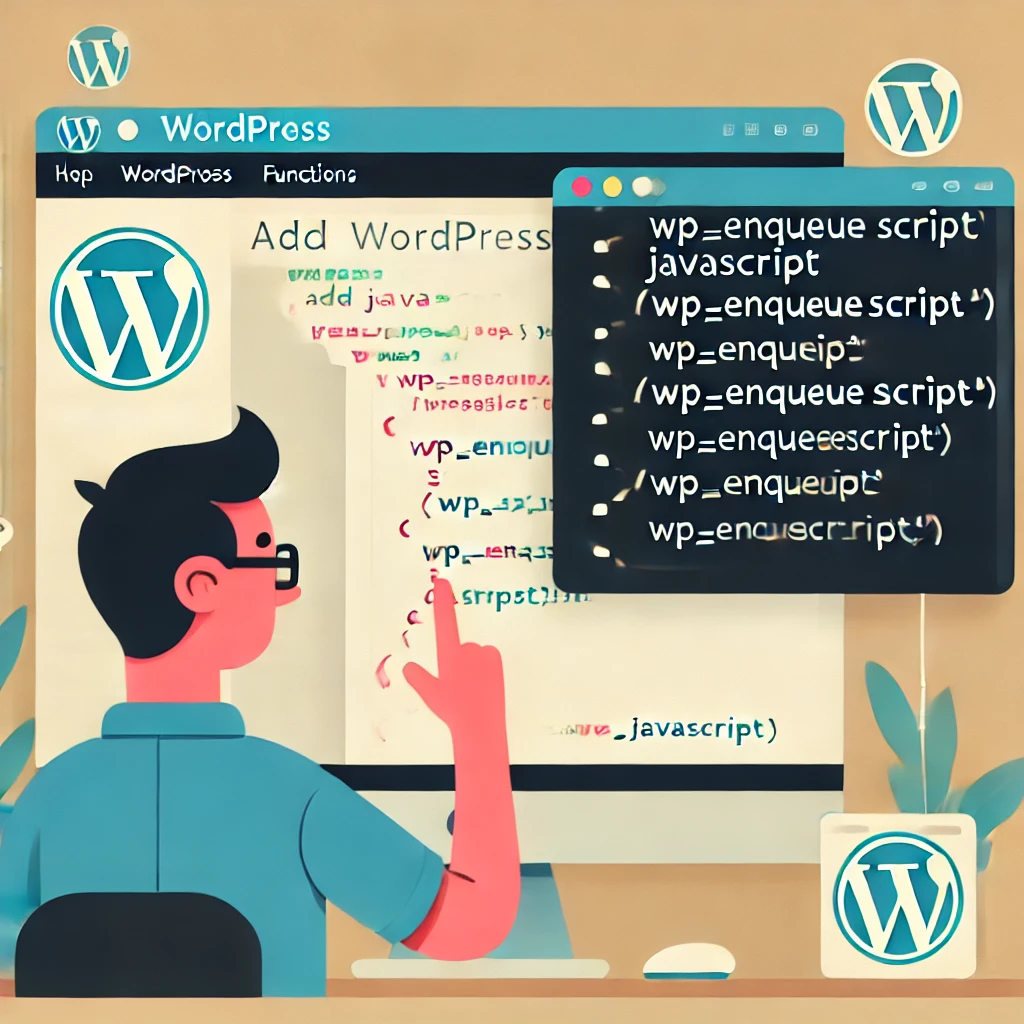
El uso de ganchos y funciones de WordPress le permite añadir JavaScript a partes específicas de su sitio sin necesidad de editar directamente los archivos del tema.
Uso de la función wp_enqueue_script(): La función wp_enqueue_script() añade archivos JavaScript personalizados a su tema de WordPress. He aquí cómo:
function add_custom_js() {
wp_enqueue_script( 'my-custom-js', get_template_directory_uri() . '/js/custom.js', array(), false, true );
}
add_action( 'wp_enqueue_scripts', 'add_custom_js' );Este método garantiza que los archivos JavaScript se carguen correctamente y no entren en conflicto con otras bibliotecas o temas.
Añadir JavaScript a entradas o páginas específicas: Puede añadir JavaScript sólo a un post o página en particular. Utilice el siguiente código para hacerlo:
function add_custom_js_to_page() {
if ( is_single( '1' ) ) { // Sustituya '1' por el ID de su entrada o página
?>
<?php
}
}
add_action( 'wp_head', 'add_custom_js_to_page' );Sustituya 1 con el ID real de la entrada o página, y el JavaScript se añadirá sólo a esa página.
Ejemplo de caso práctico:
Digamos que tiene una promoción especial en una página de producto específica y quiere añadir JavaScript que sólo afecte a esa página: este método le permite hacerlo.
Resumen:
- Pros: Control preciso sobre dónde se ejecuta el JavaScript, evita conflictos de código.
- Contras: Requiere familiaridad con los ganchos de WordPress, más complejo para principiantes.
Historia rápida: Una vez necesité añadir un temporizador de cuenta atrás a la página de un solo producto durante una venta. El uso de ganchos me permitió añadirlo sin problemas y sin afectar al resto del sitio.
Desafío: Utilice el wp_enqueue_script() para añadir JavaScript a una página específica de su sitio. Pruebe a añadir un temporizador de cuenta atrás o un mensaje personalizado para hacer la página más interactiva.
Método 4: Crear un plugin personalizado
Si prefiere mantener su código JavaScript independiente de su tema, puede crear un plugin personalizado para añadir JavaScript.

Pasos para crear un plugin personalizado:
- En el
wp-content/pluginscree una nueva carpeta llamadami-plugin-javascript. - Dentro de esta carpeta, cree un nuevo archivo llamado
mi-plugin-javascript.php. - Añada la siguiente cabecera del plugin y el código JavaScript:
4.Guarde y suba este archivo a su servidor. Ahora debería ver su plugin personalizado listado en el Plugins de WordPress página.
5.Active el plugin, y su código JavaScript se ejecutará. Ejemplo de caso práctico:
Esto es ideal cuando desea una pieza de funcionalidad JavaScript que no está ligada a un tema específico-quizás desea que persista incluso si cambia de tema más adelante.
Resumen:
- Pros: Mantiene el JavaScript personalizado separado del tema, haciéndolo más flexible y portable.
- Contras: Requiere algunos conocimientos de desarrollo de plugins y más configuración inicial.
Consejo profesional: Crear su plugin puede parecer desalentador, pero es una gran manera de hacer que su código reutilizable a través de diferentes temas o proyectos.Desafío: Cree un sencillo plugin personalizado que añada una alerta de "¡Hola, mundo!" a su sitio. Esta es una gran manera de familiarizarse con el desarrollo de plugins.
Método 5: Añadir JavaScript a los widgets
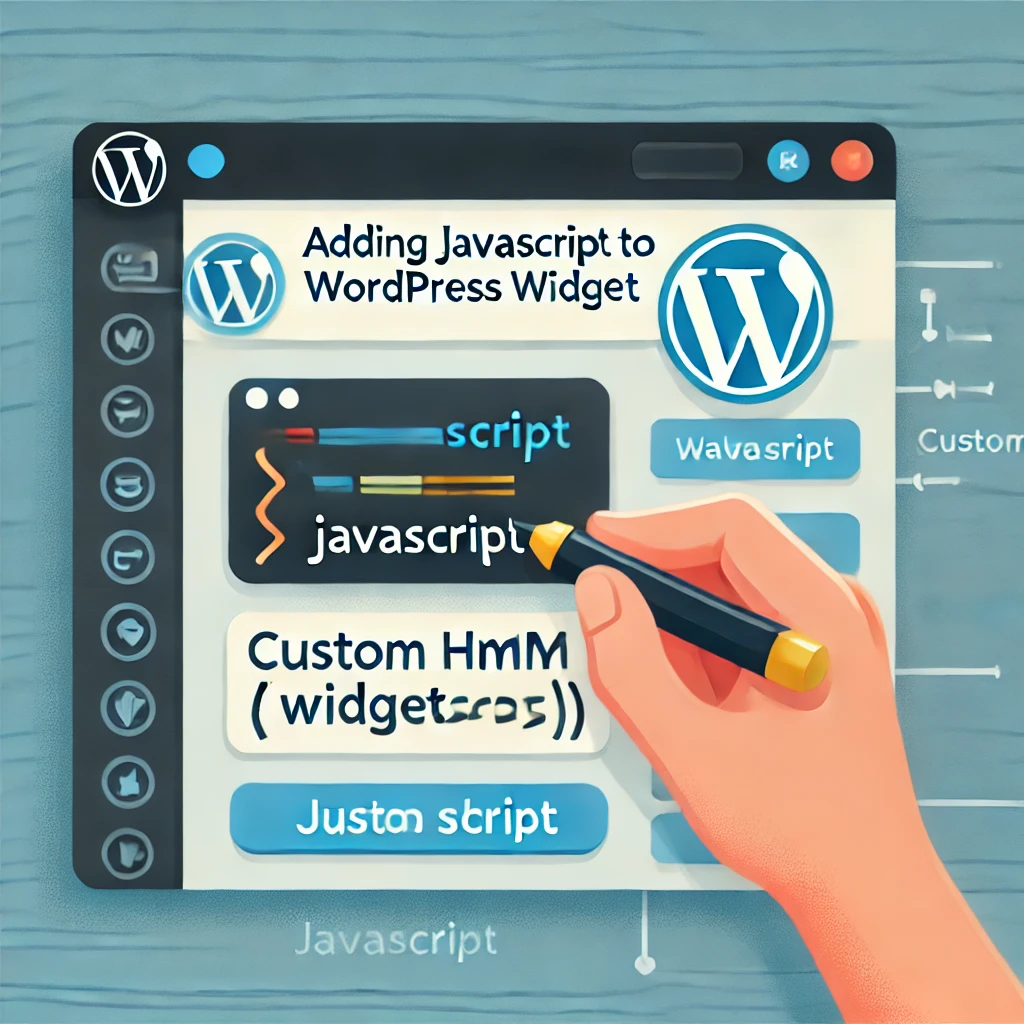
Para añadir JavaScript a un widget, siga estos pasos:
- Navegue hasta el Widgets en su panel de control de WordPress.
- Añada un HTML personalizado widget a su barra lateral o pie de página.
- Inserte su código JavaScript utilizando el
<script>etiqueta:
<script>
alert("Hello, this is a widget alert!");
</script>Ejemplo de caso práctico:
¿Desea añadir un mensaje de bienvenida o alguna interacción divertida en su barra lateral? Añadir JavaScript a una zona de widgets es una opción perfecta.
Resumen:
- Pros: Rápido y fácil de añadir JavaScript a áreas específicas de widgets.
- Contras: Alcance limitado, puede no ser ideal para guiones grandes.
Desafío: Añada un mensaje de bienvenida basado en JavaScript a una zona de widgets de su sitio. Esto le permitirá ver cómo funcionan los widgets con scripts personalizados.
Añadir JavaScript al pie de página
También puede añadir JavaScript al pie de página de su sitio WordPress. La forma más sencilla de hacerlo es utilizando el gancho wp_footer en el archivo functions.php de su tema.function add_js_to_footer() {
?>
<?php
}
add_action( 'wp_footer', 'add_js_to_footer' );Esto asegura que el JavaScript se cargue en último lugar, lo que puede mejorar la velocidad del sitio y evitar problemas con el Modelo de Objetos del Documento (DOM) que no esté listo.
Ejemplo de caso práctico:
Cargar JavaScript en el pie de página puede ser muy útil para los scripts de seguimiento, como Google Analytics, ya que garantiza que no afecten a la velocidad de carga de su contenido principal.
Resumen:
- Pros: Asegura que JavaScript se carga después del contenido principal, mejorando el rendimiento.
- Contras: Requiere conocimientos de codificación y se limita a los scripts que deben ejecutarse tras la carga de la página.
Depuración de errores de JavaScript en WordPress
A veces, JavaScript puede no comportarse como se espera. A continuación le explicamos cómo depurar errores en su sitio de WordPress:
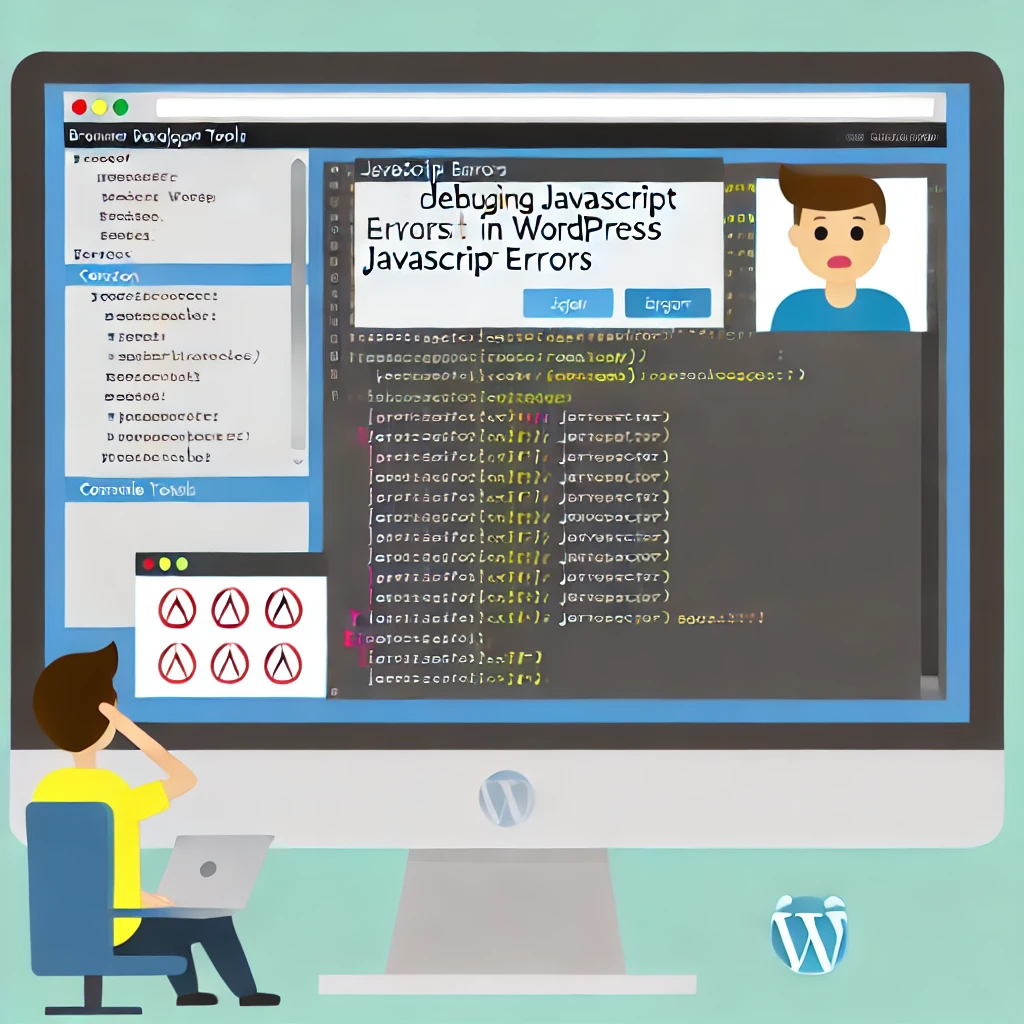
1.Utilizar la consola del navegador: Haga clic con el botón derecho del ratón en cualquier lugar de su página web, seleccione Inspeccioney luego vaya a la Consola pestaña. Aquí, verá cualquier error de JavaScript listado.
- Ejemplo de error:
Uncaught ReferenceError: myFunction no está definida. Esto significa que la función falta o tiene un nombre incorrecto.
2.Activar la depuración de scripts: Para activar la depuración para JavaScript en WordPress, añada la siguiente línea a su wp-config.php file:
define('SCRIPT_DEBUG', true);3.Desactivar plugins: Si su JavaScript no funciona como esperaba, desactive todos los plugins para ver si alguno está causando un conflicto. A continuación, reactívelos uno a uno para encontrar al culpable.
- Ejemplo de escenario: Un plugin puede anular su función JavaScript, causando un comportamiento inesperado.
4Errores comunes:
- Errores de sintaxis: Compruebe que en su código JavaScript no falten puntos y comas, que no haya corchetes o que no haya errores tipográficos.
- Rutas de archivos incorrectas: Asegúrese de que la ruta a su archivo JavaScript es correcta, especialmente cuando utilice wp_enqueue_script().
- Problemas de orden de carga: El JavaScript que dependa de elementos aún no disponibles en el DOM debe envolverse dentro de un evento DOMContentLoaded o window-onload.
document.addEventListener('DOMContentLoaded', function() {
// Su código aquí
});Ejemplo de la vida real: Una vez pasé horas depurando un problema, sólo para darme cuenta de que olvidé envolver mi script en un evento DOMContentLoaded, haciendo que se ejecutara antes de que se cargaran los elementos necesarios. ¡Lección aprendida!
Herramientas y recursos
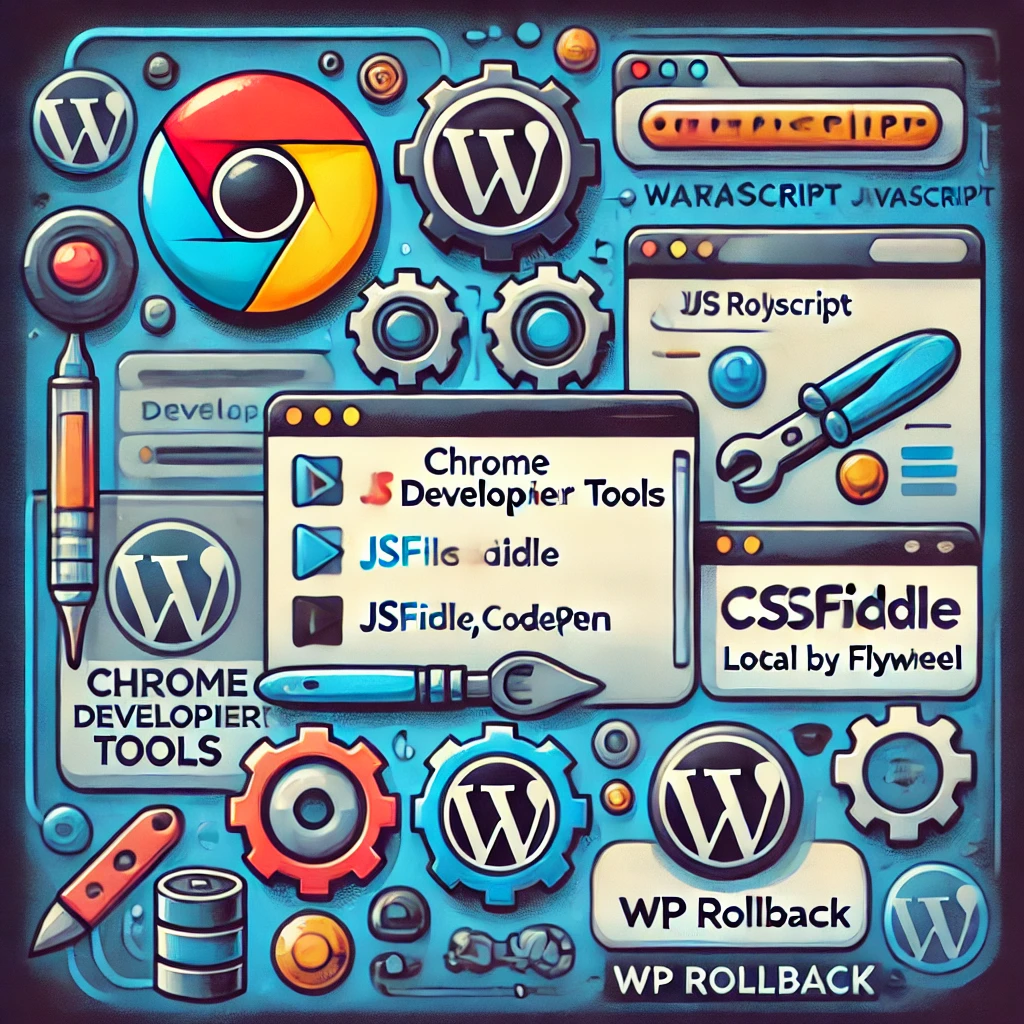
Aquí tiene algunas herramientas y recursos que pueden ayudarle mientras trabaja con JavaScript en WordPress:
- Herramientas para desarrolladores de Chrome: Ideal para inspeccionar elementos y depurar código JavaScript directamente en el navegador.
- JSFiddle / CodePen: Utilice estos campos de juego en línea para probar pequeños fragmentos de código JavaScript antes de añadirlos a su sitio.
- Local de Flywheel: Una herramienta para crear un entorno local de WordPress en el que podrá probar JavaScript de forma segura.
- WP Rollback: Si la actualización de un plugin rompe su JavaScript, puede utilizar WP Rollback para volver a una versión anterior.
Consejo rápido: Utilice herramientas como JSFiddle para experimentar rápidamente con JavaScript. Le evita romper potencialmente su sitio WordPress durante las pruebas.
Preguntas frecuentes (FAQ)
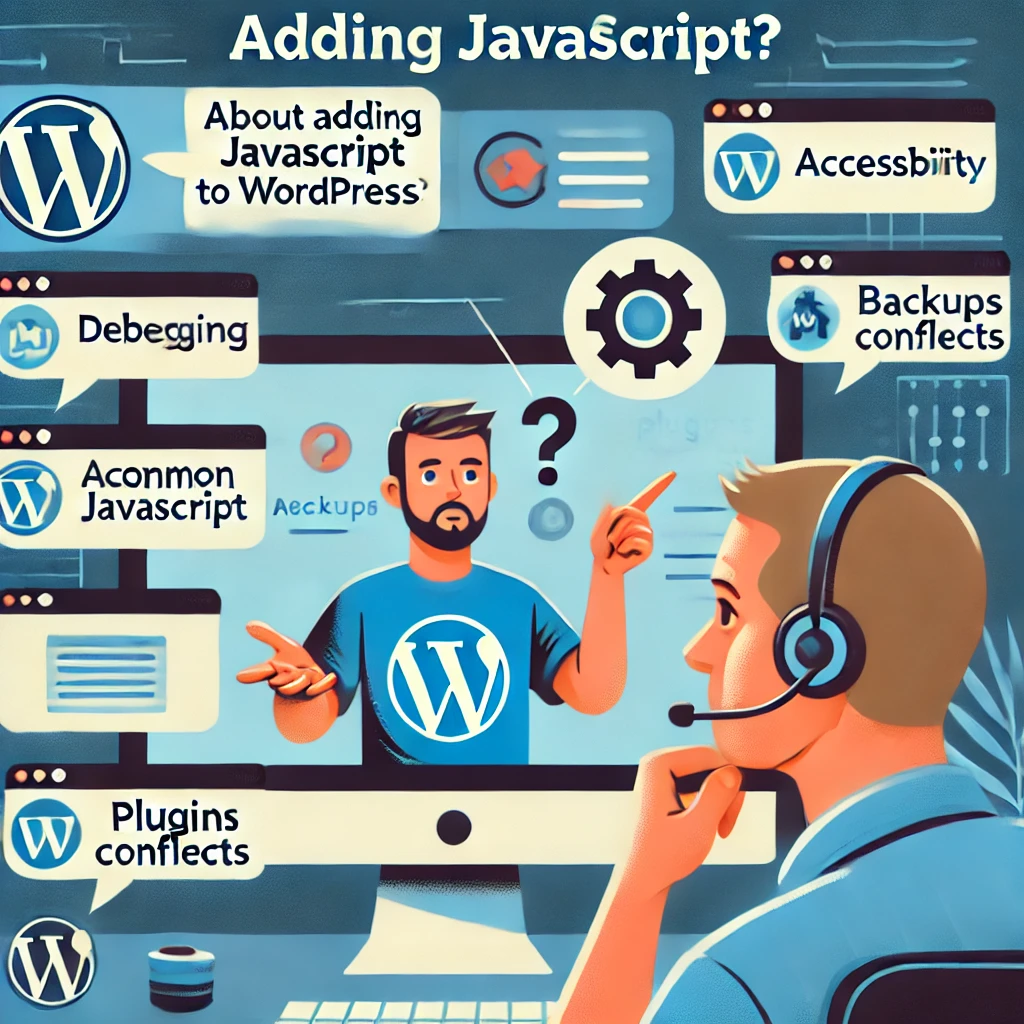
1. ¿Puedo añadir JavaScript sólo a determinadas páginas?
Puede utilizar los ganchos de WordPress y las etiquetas condicionales para añadir JavaScript a páginas específicas. Por ejemplo, is_single() puede dirigirse a entradas individuales.
2. ¿Qué pasa si mi JavaScript rompe mi sitio?
Utilice siempre una copia de seguridad antes de añadir código personalizado. Puede restaurar su sitio a un estado de trabajo si se produce un error.
3. ¿Por qué no funciona mi JavaScript?
Compruebe si hay errores en la consola del navegador, asegúrese de que el script se carga correctamente y verifique que no haya conflictos con otros plugins o temas.
4. ¿Cómo puedo asegurarme de que mi JavaScript no afecta a la accesibilidad?
Asegúrese de que las interacciones de JavaScript sean accesibles mediante el teclado y proporcione alternativas para los lectores de pantalla. Evite el uso de JavaScript, que interrumpe el flujo normal de la página.
Conclusión

Cuadro sinóptico:
| Método | Pros | Contras |
|---|---|---|
| Plugin | Fácil, no requiere codificación | Flexibilidad limitada, conflictos potenciales |
| Archivos temáticos | Control total, fácil integración | Riesgo durante la actualización de temas |
| Ganchos y funciones | Control preciso, menos propenso a los conflictos | Requiere conocimientos de codificación |
| Plugin personalizado | Independiente del tema, flexible | Requiere conocimientos de desarrollo de plugins |





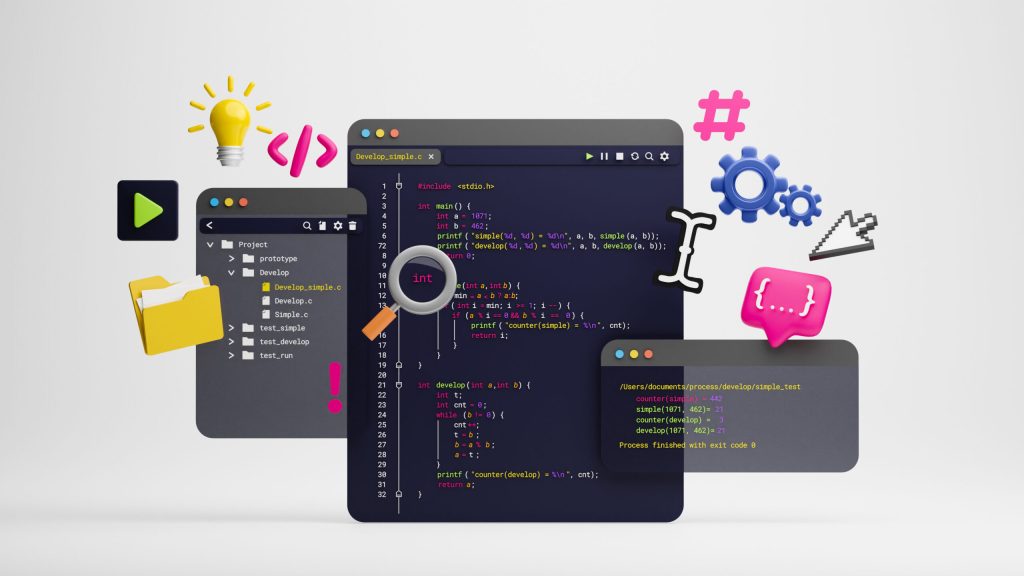

Respuestas